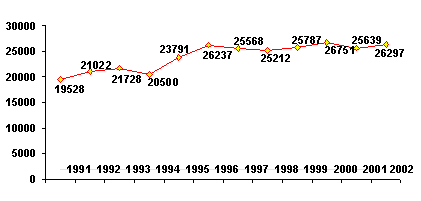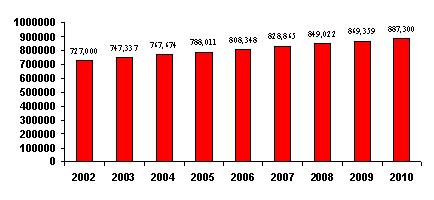By Wendy Abdo, Staff Writer and Michael Broxterman, COO of Pinnacle Health Group.
Many aspects contribute to the changing face of physician compensation. From a recruiter’s perspective, the biggest factors rest in the supply and demand for physicians based on the specialty and practice location.
The Laws of Supply and Demand
Before 1996, there was a marked upward climb in the supply of residents and fellows. However, after 1996, the overall supply leveled out. To make matters worse, the 9/11 terrorist attacks caused a tightening of immigration laws that made it more difficult for international medical graduates to enter the United States.
Supply of Final Year U.S. Residents/Fellows

Source: Bowling, Jeff. Numbers: Data and Facts that Affect Your Department and Firm, March 29, 2003
Still, the overall physician workforce is experiencing a slow increase, primarily due to the influx of international medical graduates.
What About Demand?
Low physician reimbursements and the tight supply of physicians increase demand. Furthermore, as the total physician supply experiences slow growth, the U. S. population is growing at a much faster rate. This means physicians must work harder and smarter and see more patients to maintain the same level of compensation.
What does that mean for others? As more people demand physician services, patients may notice an increased wait time when visiting their doctors. Health care providers may find that they need to offer higher compensation for certain in-demand specialties such as urology, gastroenterology, orthopedic surgery, otolaryngology, and cardiovascular disease to attract physicians.
Are Changes Likely?
Richard A. Cooper of Health Affairs predicted a shortage of 200,000 physicians by 2020 and COGME has reversed its position and now sees a shortage of over 90,000 physicians by 2020. Even the American Medical Association has acknowledged that physician shortages exist.
The next logical step would be to increase the number of medical students. Yet, even if medical schools were to increase enrollments today, it would take about ten years to change this trend. This is not an easy process for COGME. Medical schools will have to increase their faculty and staff and raise the needed funds to include more training programs for its increased enrollment. While COGME is currently increasing the number of entrants, they are not increasing this number enough to meet future demand, as predicted.
Predicted Physician Workforce

Source: Bowling, Jeff. Numbers: Data and Facts that Affect Your Department and Firm, March 29, 2003
Physician Maldistribution
Many rural and inner-city communities see increasing physician shortages. In a study done by COGME, top reasons for this geographic maldistribution of physicians include professional isolation in a non-collegial setting, income reduction due to increased number of uninsured in area, lack of physical and cultural amenities, and the difficulty family members face in finding employment in the underserved community.
There has always been a maldistribution of physicians in urban and rural areas. This problem, still occurring today, is compounded by the overall shortage of physicians in all locations.
Factors Influencing Compensation
The following is a list of factors that affect physician compensation:
- Growth of U.S. population
- Early retirement
- Malpractice costs
- Decreasing/stagnant reimbursement
- Tightened restrictions on international physician supply
- Increased physician turnover
In past years, physicians have experienced increased compensation. However, recent compensation surveys reveal a leveling off of physician compensation.
According to the MGMA, some specialties have not increased substantially. From 2002 to 2003, all primary care specialties showed a modest increase of 2.4% while other specialties showed huge increases. Big increases occurred in urology (16.89%), noninvasive cardiology (13.59%), and orthopedic surgery (9.63%). However, the biggest change in 2002-2003 was a 17.94% increase in compensation for Ophthalmology.
Obviously, tendencies in physician incomes will vary depending on the specialty and location; however, overall compensation for most doctors will remain relatively stable except for some in-demand specialties that will show a marked increase. We also anticipate seeing an increased demand for services, a tighter supply of physicians, and stagnant reimbursements. Ultimately, it will become a longer process to place physicians in open positions.